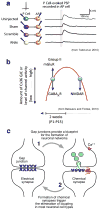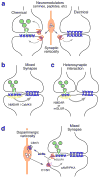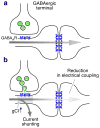Electrical synapses and their functional interactions with chemical synapses
- PMID: 24619342
- PMCID: PMC4091911
- DOI: 10.1038/nrn3708
Electrical synapses and their functional interactions with chemical synapses
Abstract
Brain function relies on the ability of neurons to communicate with each other. Interneuronal communication primarily takes place at synapses, where information from one neuron is rapidly conveyed to a second neuron. There are two main modalities of synaptic transmission: chemical and electrical. Far from functioning independently and serving unrelated functions, mounting evidence indicates that these two modalities of synaptic transmission closely interact, both during development and in the adult brain. Rather than conceiving synaptic transmission as either chemical or electrical, this article emphasizes the notion that synaptic transmission is both chemical and electrical, and that interactions between these two forms of interneuronal communication might be required for normal brain development and function.
Figures






Similar articles
-
On the occurrence and enigmatic functions of mixed (chemical plus electrical) synapses in the mammalian CNS.Neurosci Lett. 2019 Mar 16;695:53-64. doi: 10.1016/j.neulet.2017.09.021. Epub 2017 Sep 11. Neurosci Lett. 2019. PMID: 28911821 Free PMC article. Review.
-
Antidromic-rectifying gap junctions amplify chemical transmission at functionally mixed electrical-chemical synapses.Nat Commun. 2017 Mar 20;8:14818. doi: 10.1038/ncomms14818. Nat Commun. 2017. PMID: 28317880 Free PMC article.
-
Wiring prior to firing: the evolutionary rise of electrical and chemical modes of synaptic transmission.Rev Neurosci. 2014;25(6):821-32. doi: 10.1515/revneuro-2014-0037. Rev Neurosci. 2014. PMID: 25051277 Review.
-
Activity-dependent plasticity of electrical synapses: increasing evidence for its presence and functional roles in the mammalian brain.BMC Cell Biol. 2016 May 24;17 Suppl 1(Suppl 1):14. doi: 10.1186/s12860-016-0090-z. BMC Cell Biol. 2016. PMID: 27230776 Free PMC article. Review.
-
Electrical transmission: Two structures, same functions?Dev Neurobiol. 2017 May;77(5):517-521. doi: 10.1002/dneu.22488. Dev Neurobiol. 2017. PMID: 28188695 Free PMC article. Review.
Cited by
-
Digitally embodied lifespan neurocognitive development and Tactile Internet: Transdisciplinary challenges and opportunities.Front Hum Neurosci. 2023 Feb 10;17:1116501. doi: 10.3389/fnhum.2023.1116501. eCollection 2023. Front Hum Neurosci. 2023. PMID: 36845878 Free PMC article.
-
A Flexible Tribotronic Artificial Synapse with Bioinspired Neurosensory Behavior.Nanomicro Lett. 2022 Dec 29;15(1):18. doi: 10.1007/s40820-022-00989-0. Nanomicro Lett. 2022. PMID: 36580114 Free PMC article.
-
Detecting Early Cognitive Decline in Alzheimer's Disease with Brain Synaptic Structural and Functional Evaluation.Biomedicines. 2023 Jan 26;11(2):355. doi: 10.3390/biomedicines11020355. Biomedicines. 2023. PMID: 36830892 Free PMC article. Review.
-
Quasi-two-dimensional α-molybdenum oxide thin film prepared by magnetron sputtering for neuromorphic computing.RSC Adv. 2022 Jun 15;12(28):17706-17714. doi: 10.1039/d2ra02652j. eCollection 2022 Jun 14. RSC Adv. 2022. PMID: 35765332 Free PMC article.
-
Gene transcriptional expression of cortical thinning during childhood and adolescence.Hum Brain Mapp. 2023 Jul;44(10):4040-4051. doi: 10.1002/hbm.26328. Epub 2023 May 5. Hum Brain Mapp. 2023. PMID: 37146003 Free PMC article.
References
-
-
The Synapse by Bernardo Sabatini Morgan Sheng | 9781936113026 | Hardcover | Barnes & Noble.
-
-
- Bennett MVL, Zukin RS. Electrical coupling and neuronal synchronization in the Mammalian brain. Neuron. 2004;41:495–511. - PubMed
-
- Zoli M, et al. The emergence of the volume transmission concept. Brain Res Brain Res Rev. 1998;26:136–47. - PubMed
-
- Faber DS, Korn H. Electrical field effects: their relevance in central neural networks. Physiol Rev. 1989;69:821–63. - PubMed
-
- Connors BW, Long MA. Electrical synapses in the mammalian brain. Annu Rev Neurosci. 2004;27:393–418. - PubMed
Publication types
MeSH terms
Grants and funding
LinkOut - more resources
Full Text Sources
Other Literature Sources

